Story at a glance:
- Mass timber refers to a category of wood products in which multiple layers of solid wood panels have been affixed to one another by glue, nails, or dowels.
- Buildings that make extensive use of mass timber in their frameworks or structural elements are considered mass timber buildings.
- The tallest mass timber building in the world is the Ascent building in Milwaukee, which stands at 284.1 feet tall.
In recent years technological advancements in engineered wood—particularly mass timber—have allowed for greater innovation and ingenuity when it comes to constructing large structures wholly or partially from wood.
Mass timber products like cross-laminated timber and glued-laminated timber have given rise to office buildings, apartment complexes, and high-rises whose frameworks and load-bearing elements are made not from steel or concrete, but wood.
This article highlights 25 tallest completed mass timber buildings from around the world, as compiled using data gathered by the Council on Tall Buildings and Urban Habitats.
What is Mass Timber?
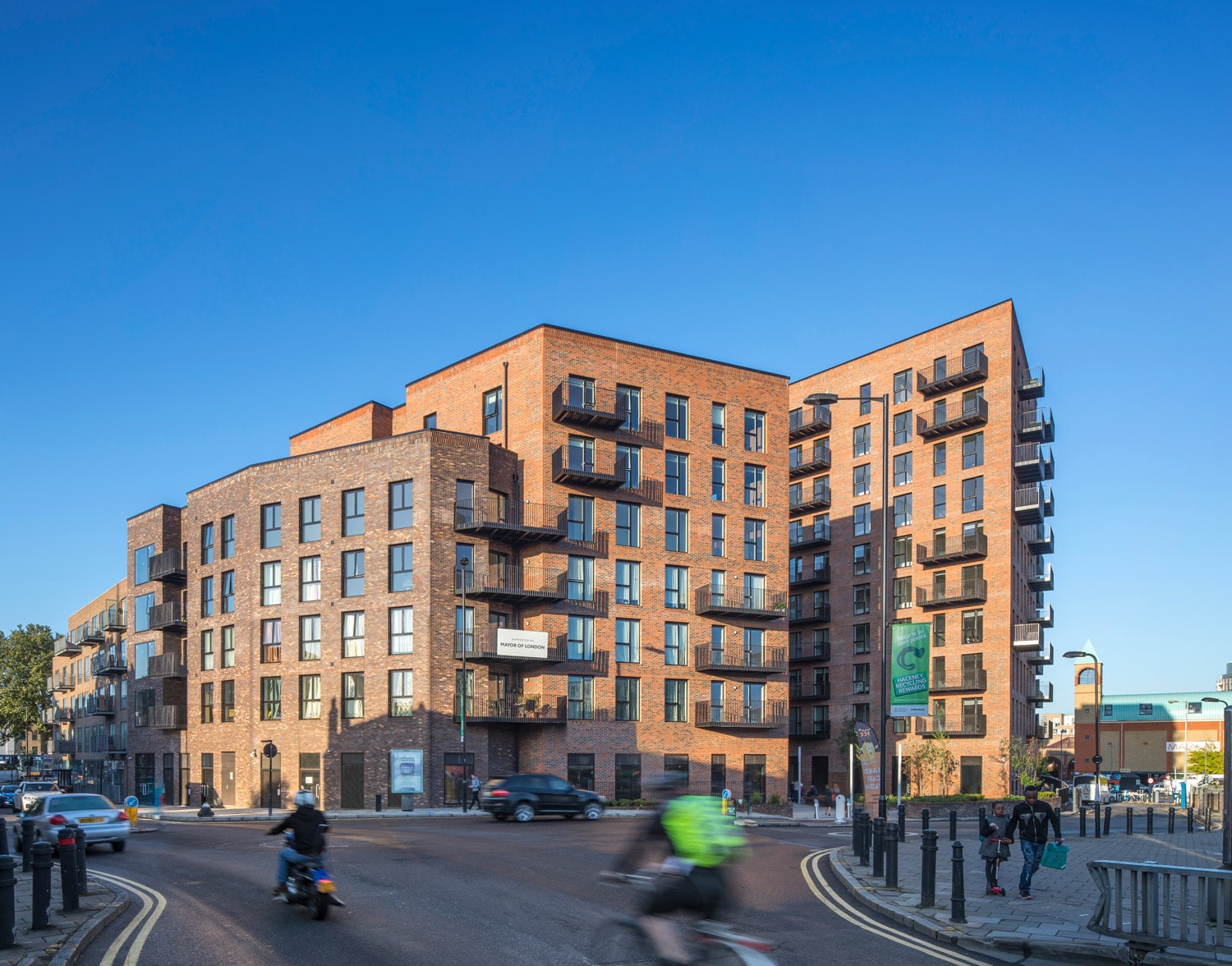
Dalston Works is one of the world’s largest CLT buildings. Photo by Daniel Shearing
When it comes to construction, mass timber refers to a subset of engineered wood made by binding together multiple layers of wood planks. The resulting product is much stronger and more structurally-sound than traditional timber, which allows it to be used as a viable, low-carbon alternative to concrete.
In general, there are four main categories of mass timber: cross-laminated, nail-laminated, dowel-laminated, and glued-laminated.
- Cross-laminated timber (CLT). Several layers (typically an odd number) of wood planks are glued together, with each layer perpendicular to the one above and below it.
- Nail-laminated timber (NLT). One of the oldest forms of mass timber; layers of wood are bound together by nails.
- Dowel-laminated timber (DLT). Wood planks are drilled and then bound together by long wooden dowels.
- Glued-laminated timber (Glulam). Layers of wooden planks are attached to one another using glue.
These mass timber products offer increased compression strength and flexibility compared to traditional raw timber. As a result, they can be used to construct load-bearing features such as structural panels, beams, and posts, opening up a whole new world of possibilities for large-scale timber construction.
The Top 25 Tallest Mass Timber Buildings in the World
1. Ascent MKE, Milwaukee
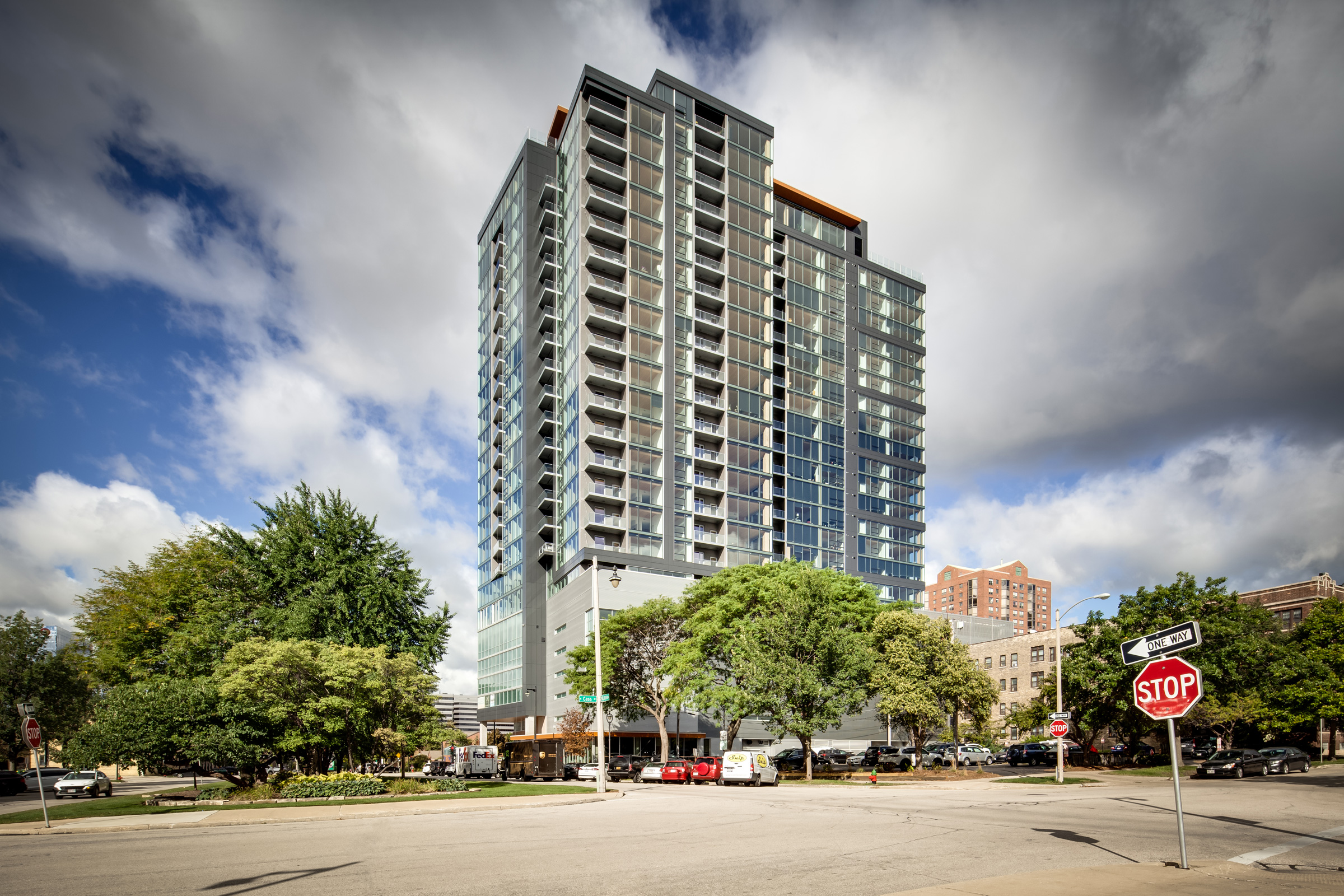
The Ascent MKE building in Milwaukee, Wisconsin is the tallest mass timber building in the world. Photo courtesy of Korb + Associates Architects
Designed by Korb + Associates Architects and 284 feet tall, the Ascent MKE building in Milwaukee currently holds the title of tallest mass timber building in both the US and the world.
Aside from the building’s base, stair and elevator shafts—which are all made from concrete—Ascent was constructed primarily from sustainably-sourced glulam beams and columns as well as cross-laminated timber floor panels. Wood used in the interior was largely left exposed as a means of bolstering occupant comfort and as testament to the client’s interest in biophilic design.
Due to its extensive use of timber, Ascent MKE is estimated to sequester roughly 7,200 metric tons of CO2. The lightweight nature of wood also resulted in faster construction and reduced waste production.
Rising 25 stories off the ground, Ascent’s first six floors are dedicated to amenities and retail space, whereas the remaining nineteen floors house 259 luxury apartment units.
2. Mjøstårnet, Brumunddal, Norway
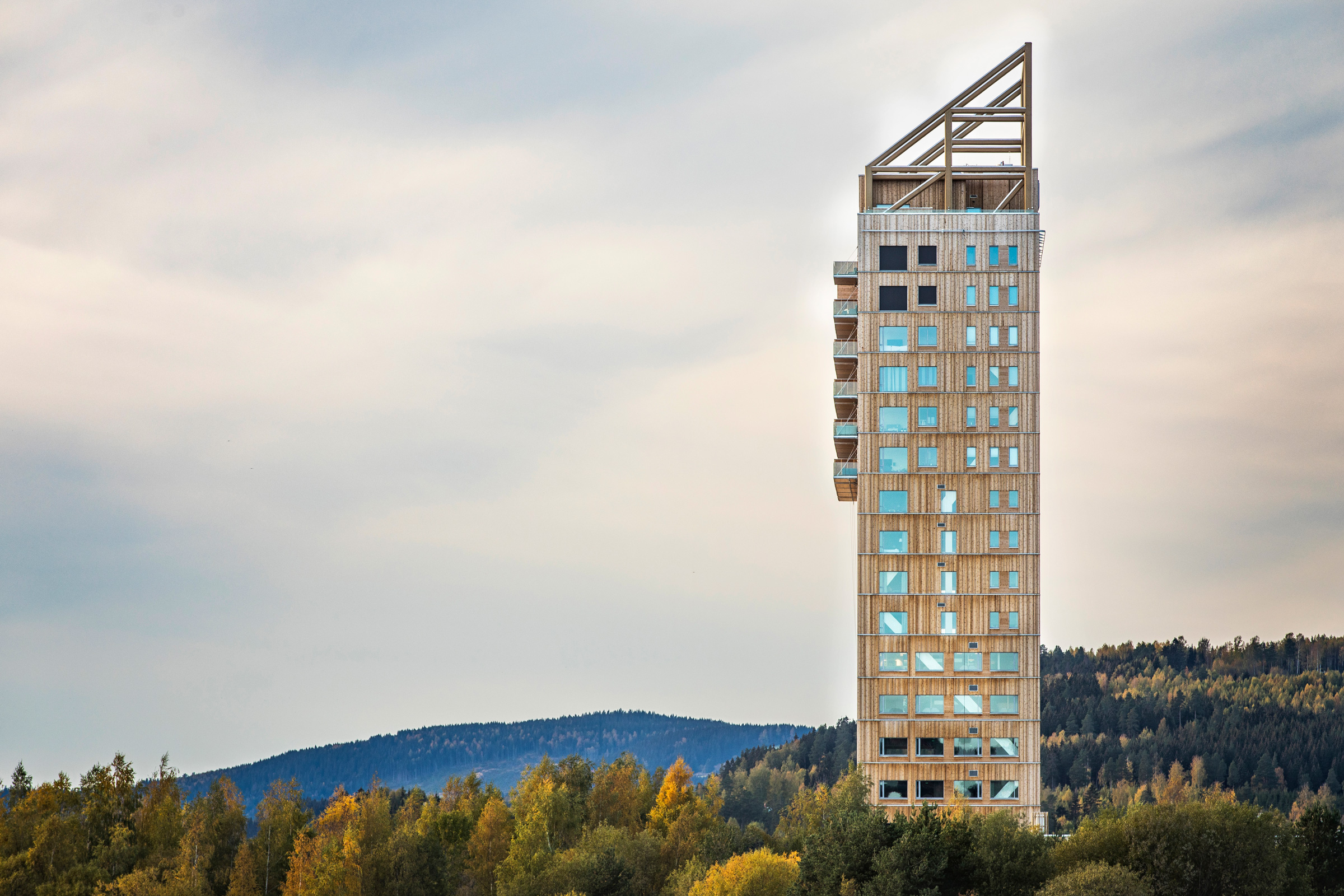
Designed by Norwegian architecture studio Voll Arkitekter, Mjøstårnet is the tallest mass timber building in Europe. Photo by Voll Arkitekter + Rikardo Foto
Completed in 2019, the 280-foot-tall Mjøstårnet building—which translates to ‘the tower of Lake Mjøsa’—in Brumunddal, Norway is recognized as the tallest mass timber building in Europe. When it first opened the tower was certified as the tallest timber building in the world.
Designed by Norwegian architecture firm Voll Arkitekter, Mjøstårnet is considered to be an all-timber structure due to the fact that all floor-spanning systems and the main lateral/vertical structural elements are built from wood. Concrete was used—albeit sparingly—on the building’s top-most floors to satisfy acoustic and comfort requirements.
Glued-laminated timber was used for Mjøstårnet’s load-bearing elements and CLT was used to construct all balconies, stairwells, and elevator shafts. Due to the build site’s proximity to a major forestry and wood-processing hub, all timber was able to be sourced locally, thereby reducing transportation times and emissions.
Today Mjøstårnet is home to offices, apartments, a restaurant, several common areas, and a hotel.
3. HoHo Wien, Vienna, Austria
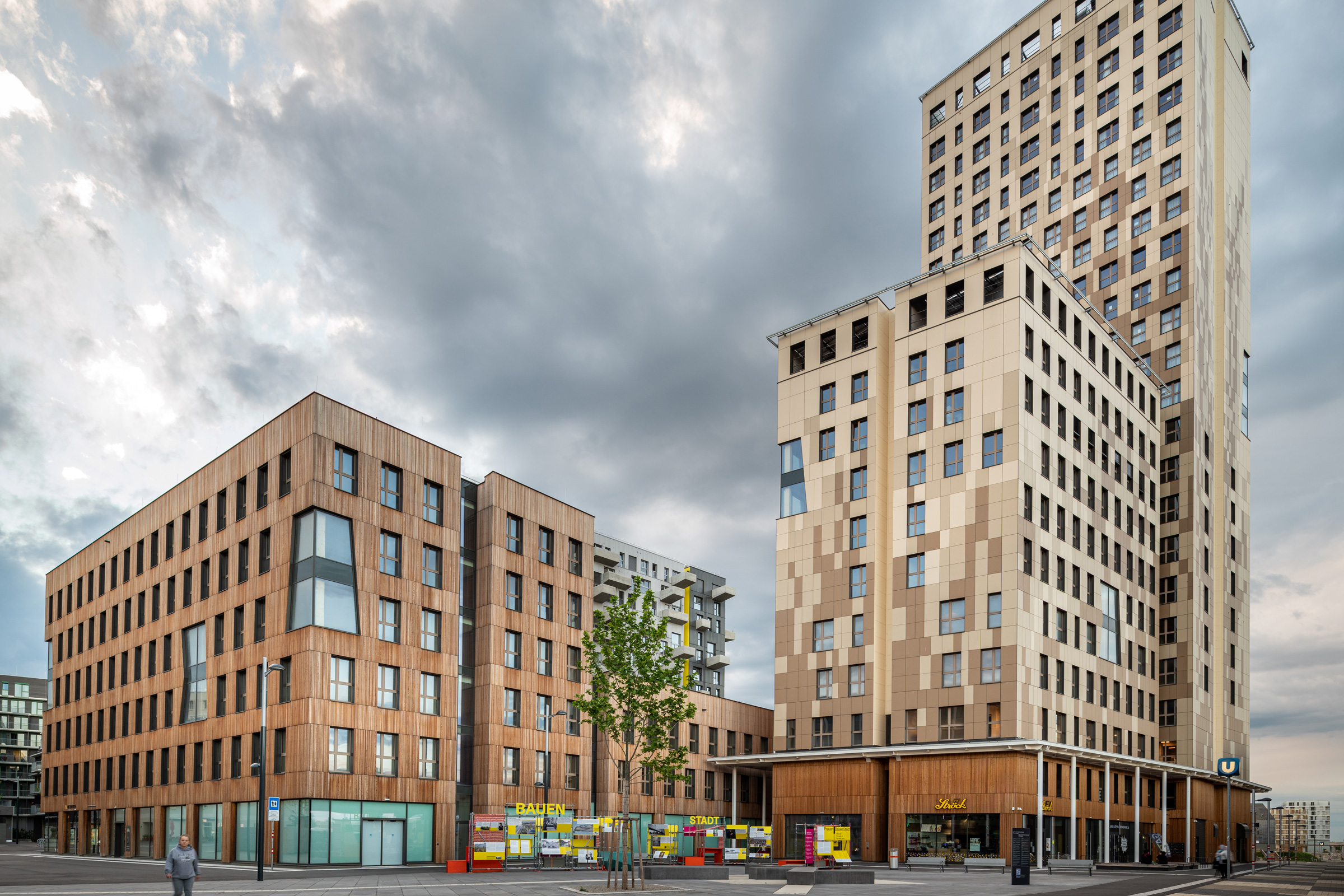
Designed by RLP Rüdiger Lainer + Partner, the HoHo Wien building has won multiple awards for its extensive and innovative use of mass timber. Photo by György Palkó
The RLP Rüdiger Lainer + Partner–designed HoHo Wien building in Vienna is a 24-floor timber-and-concrete mixed-use structure is nearly 276 feet tall.
Completed in 2019, the high-rise uses sustainably sourced wood for approximately 74% of its construction (chiefly the walls, ceilings, and interior support structure), complemented primarily by precast concrete, which makes up the building’s core.
HoHo Wien uses a docked wooden structure—composed of a ceiling element, edge beam, and supports—for the building’s framework. Cross-laminated timber panels, supported by concrete girders, help manage the structure’s floor-by-floor load transfer.
Thanks to its inspired use of timber, HoHo Wien was awarded the City of Vienna Architecture Prize in 2019, as well as both the Lower Austrian Timber Construction Prize and the Wienwood Award in 2021.
HoHo Wien houses offices, apartments, a hotel, restaurant, businesses, and a wellness area.
4. HAUT, Amsterdam
At 240 feet and 21 stories, the HAUT Amsterdam Residential Building is one of the tallest mass timber structures in the Netherlands, let alone the world.
Designed by Team V Architecture, the HAUT building utilizes pre-manufactured CLT panels for its load-bearing structure and timber planks for all walls, floors, and ceilings. Due to its warm, inviting appearance, much of the wood used in HAUT’s interior construction is left exposed.
To ensure stability HAUT’s basement, foundation, and cores are all built from concrete. Overall the project sought to eliminate materials like concrete and steel wherever possible due to their high production of carbon emissions. Indeed, this notion of sustainability was at the forefront throughout the design phase, as the building was designed to meet the highest level of BREEAM standards.
HAUT has since become a pioneer in tall timber construction and serves as inspiration for mass timber high rises all around the world.
5. Sara Kulturhus Centre, Skellefteå, Sweden

A bastion of Swedish culture and art, the Sara Kulturhus Center is one of the tallest mass timber structures in Europe. Photo by Patrick Degerman
Designed by White Arkitekter, the Sara Kulturhus Centre in Skellefteå, Sweden stands at approximately 239 feet tall with 20 floors total.
Inspired by Skellefteå’s long history of timber construction, the Sara Kulturhus Centre is built primarily from locally-sourced cross-laminated timber and glulam, supplemented where necessary by steel elements.
For the high-rise portion of the building, pre-manufactured CLT modules were stacked between twin elevator cores and supported by a framework of glulam beams and pillars. Similarly, the low-rise portion features a timber frame, glulam pillars and beams, as well as shear walls and cores made from CLT. Much of the interior timber is left exposed as a means of showcasing the center’s superb craftsmanship.
The Sara Kulturhus Centre works to preserve Swedish culture through the celebration of art in all its forms. The center currently holds the City Library, Anna Nordlander Museum, Västerbotten Regional Theatre, and Skellefteå Art Gallery, as well as The Wood Hotel.
6. De Karel Doorman, Rotterdam, the Netherlands
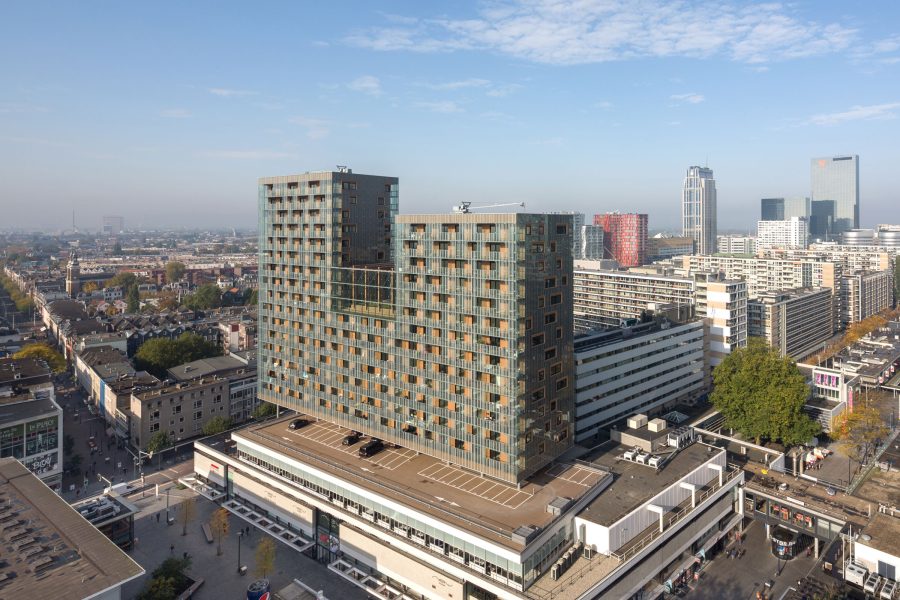
The De Karel Doorman building was designed by Ibelings van Tilburg Architecten. Photo by Ossip van Duivenbode
Traveling back to the Netherlands, the 230-foot tall De Karel Doorman in Rotterdam is an inspiring example of both mass timber construction and adaptive reuse in action.
Designed by Dutch architecture studio Ibelings van Tilburg Architecten, De Karel Doorman was adapted from the defunct Ter Meulen retail building, a holdover from the post-war reconstruction movement. Much of the original store remains—both the exterior and interior were largely restored, albeit with new residential structures on top.
Using a very light construction of timber and steel, Ibelings van Tilburg Architecten was able to add an additional 16 floors on top of the existing building’s columns and foundation without compromising its structural integrity. By opting for a timber façade and wooden floors, in conjunction with light steel, plaster partitions, and tempered glass, De Karel Doorman was made much lighter than traditional apartment buildings of a similar size.
7. 55 Southbank Boulevard, Melbourne, Australia
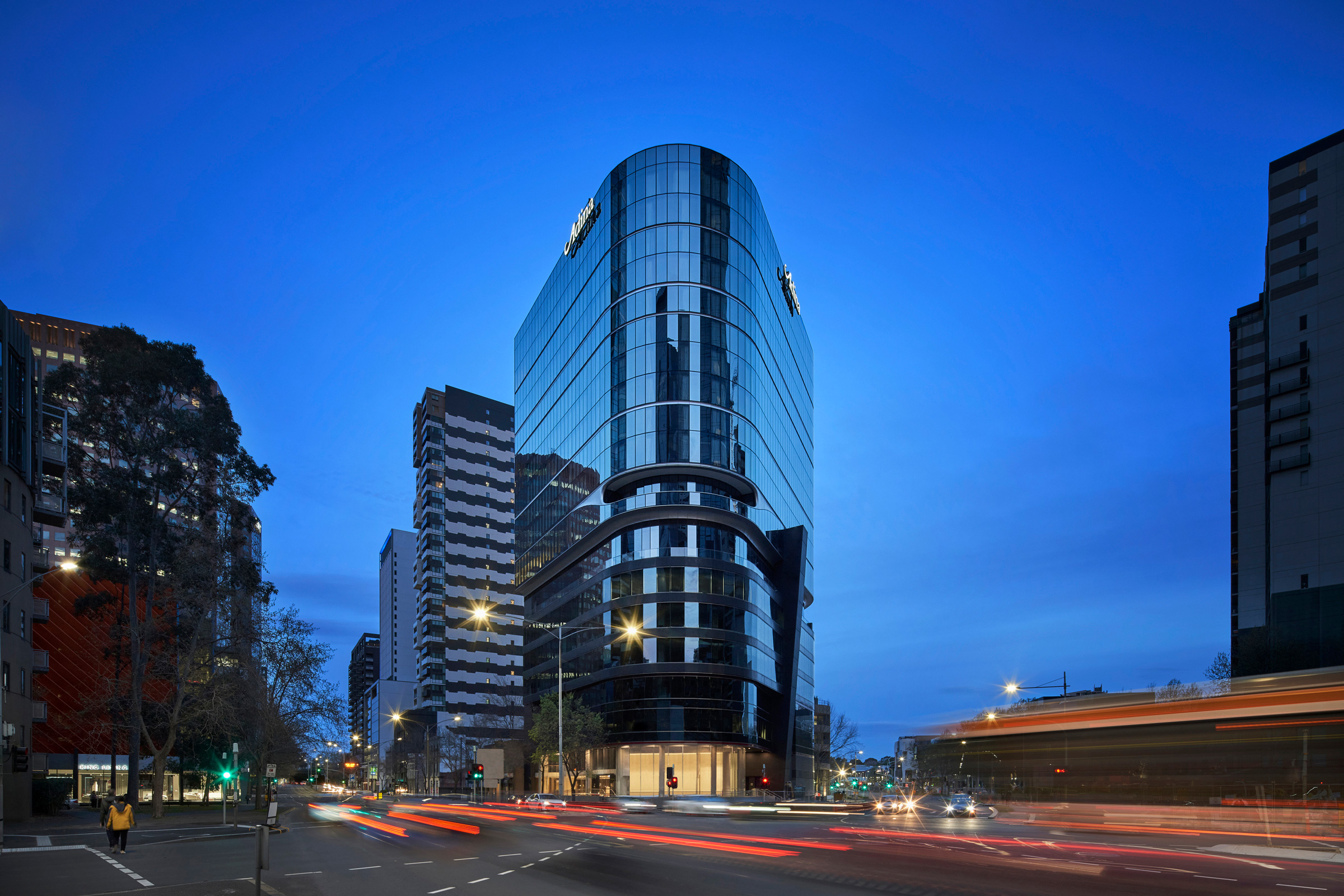
55 Southbank Boulevard is the tallest mass timber building in Australia. Photo by Peter Clarke
The Bates Smart–designed 55 Southbank in Melbourne, Australia is 228 feet tall and 19 stories. The adaptive reuse project is one of the world’s tallest vertical mass timber extensions and is Australia’s first CLT extension project.
Originally built as a commercial building in 1989, 55 Southbank Boulevard now houses the Adina Apartment Hotel, which boasts 220 rooms and an additional 15,000 square meters of floor space. A total of ten new floors were added on top of the existing concrete-and-steel structure—a feat made possible only through the use of lightweight timber elements.
Approximately 5,300 tons of sustainably sourced cross-laminated timber was used to build the extension, offsetting the amount of atmospheric CO2 emissions by more than 4,000 tons.
8. T3 Collingwood, Melbourne, Australia
Developed by global real estate specialist Hines and designed by the award-winning Jackson Clements Burrows architectural firm, T3 Collingwood is Australia’s second tallest mass timber building, measuring approximately 207 feet tall and spanning 15 floors.
The hybrid timber, concrete, and steel project is the first in Australia to utilize Hines’ T3 methodology—which emphasizes timber, transit, and technology as its core tenets—and the first to be financed through the CEFC Timber Building Program, a country-wide initiative intended to encourage mass timber construction and slash embodied carbon emissions in the built environment.
ASH—Australia’s leading mass timber manufacturer—supplied all of the glulam for the project. The company’s Australian Oak MASSLAM GLT posts and beam elements were used to construct T3 Collingwood’s top nine levels, reducing the required concrete footings and core structure in volume by approximately 15%.
As part of ASH’s and the developer’s commitment towards sustainability, all of T3 Collingwood’s timber was ethically sourced from local renewable forests, reducing both its environmental impact and transportation-related emissions. The building also saw a 34% reduction to its total embodied carbon thanks to the use of mass timber, with the material itself actually storing over 360,000 kg/CO2e.
Thanks to these—and other—green building strategies, the project was awarded a 6-star Green Star rating and 5.5 Star NABERS rating. Today, T3 Collingwood houses office space as well as restaurants and retail space on the ground floor.
9. Abro, Risch-Rotkreuz, Switzerland
Designed by Swiss architecture studio Manetsch Meyer Architekten in collaboration with Büro Konstrukt, the “Abro” building is 167 feet tall with 15 floors.
In Risch-Rotkreuz, Switzerland, the Abro building—also known as Site 1 Suurstoffi West—is one of three structures designed by Manetsch Meyer for Zug Estates and the University of Lucerne Applied Sciences and Arts campus. Abro is the tallest of these buildings and features a wood-and-concrete composition.
Timber was chosen in part for its environmentally friendly qualities, as sustainability is one of the driving factors behind the campus’ development as a whole. Their mission was to create a wholly CO2-free district. Because wood naturally sequesters carbon, its usage was an obvious choice.
10. Hyperion, Bordeaux, France

As one of the tallest mass timber buildings in Europe, Hyperion provides a variety of mixed-use services and amenities to the citizens of Bordeaux. Photo by Alban Gilbert
Named after the world’s oldest living tree, the 187-foot-tall Hyperion tower in Bordeaux is the tallest mass timber building in the country and the seventh tallest mass timber structure in Europe.
Designed by VIGUIER, Hyperion utilizes glulam and laminated veneer lumber (LVT) for its post-and-beam structure. CLT is used for the building’s partitions, floors, and balconies.
For structural reasons concrete was used to construct the building’s core as well as the first three floors. Thermal-glazed glass and steel elements were also incorporated into Hyperion’s envelope to improve insulation and solar protection.
Hyperion is in the Saint-Jean Belcier area of Bordeaux and is part of the region’s larger urban renovation efforts. It serves a variety of mixed-use purposes and houses shops, offices, and 100 residential units.
11. Eunoia Junior College, Bishan, Singapore
Eunoia Junior College in Asia is 184 feet tall with 12 floors.
The CPG Consultants–designed Eunoia Junior College in Bishan is the first mass timber high-rise educational facility in the country. The building’s facade features aluminum-clad CLT panels and the floors consist of a glulam-and-concrete composite hybrid system. All timber used for the project was sourced from sustainably managed spruce forests overseas.
Extensive use of prefabricated CLT elements allowed for quicker construction and significantly reduced the amount of construction-site waste.
Because of limited land availability, CPG Consultants had to think creatively about how to maximize the site’s productivity, resulting in the uniquely vertical layout of Eunoia Junior College. Two interconnected learning towers—of which are 10 and 12 stories high—house everything from the school’s classrooms and resource library to an indoor sports hall and dance studios.
12. Rundeskogen Hus B, Sandnes, Norway
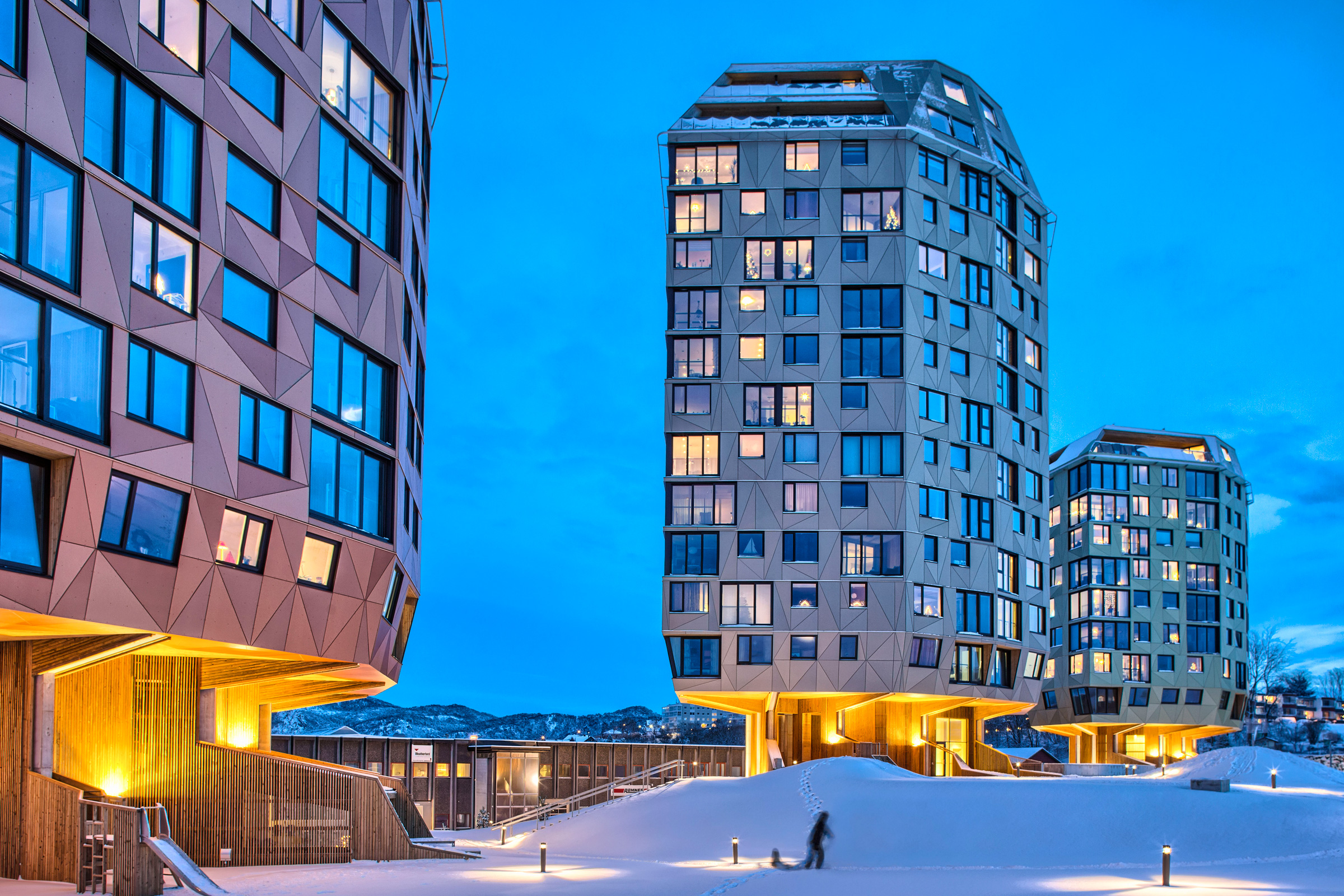
The Rundeskogen residential complex in Sandes, Norway is composed of three tree-like structures—Rundeskogen Hus B is the tallest. Photo by Sindre Ellingsen
You’ll find three tree-like towers in Sandnes, Norway—all designed by dRMM Studio and the Helen & Hard architecture studio. Together these structures make up the Rundeskogen residential complex.
Of these three, Rundeskogen Hus B is the tallest and measures approximately 177 feet tall. Originally planned as an all-timber project, changes were later made to accommodate conventional building styles, resulting in the final timber-and-concrete hybrid design.
Mass timber serves as a secondary framework material and clads the fins of the tower’s unique star-shaped concrete core—which serves to lift the first floor off the ground—giving the illusion of roots branching out from a central trunk.
By raising the tower’s first floor, Rundeskogen Hus B ultimately has a smaller project footprint, preserves the neighboring houses’ view of the fjords, and provides outdoor meeting spaces protected from the elements.
Other sustainable features include geothermal heat pumps, rooftop solar collectors, and greywater heat recovery.
13. Brock Commons Tallwood House, Canada
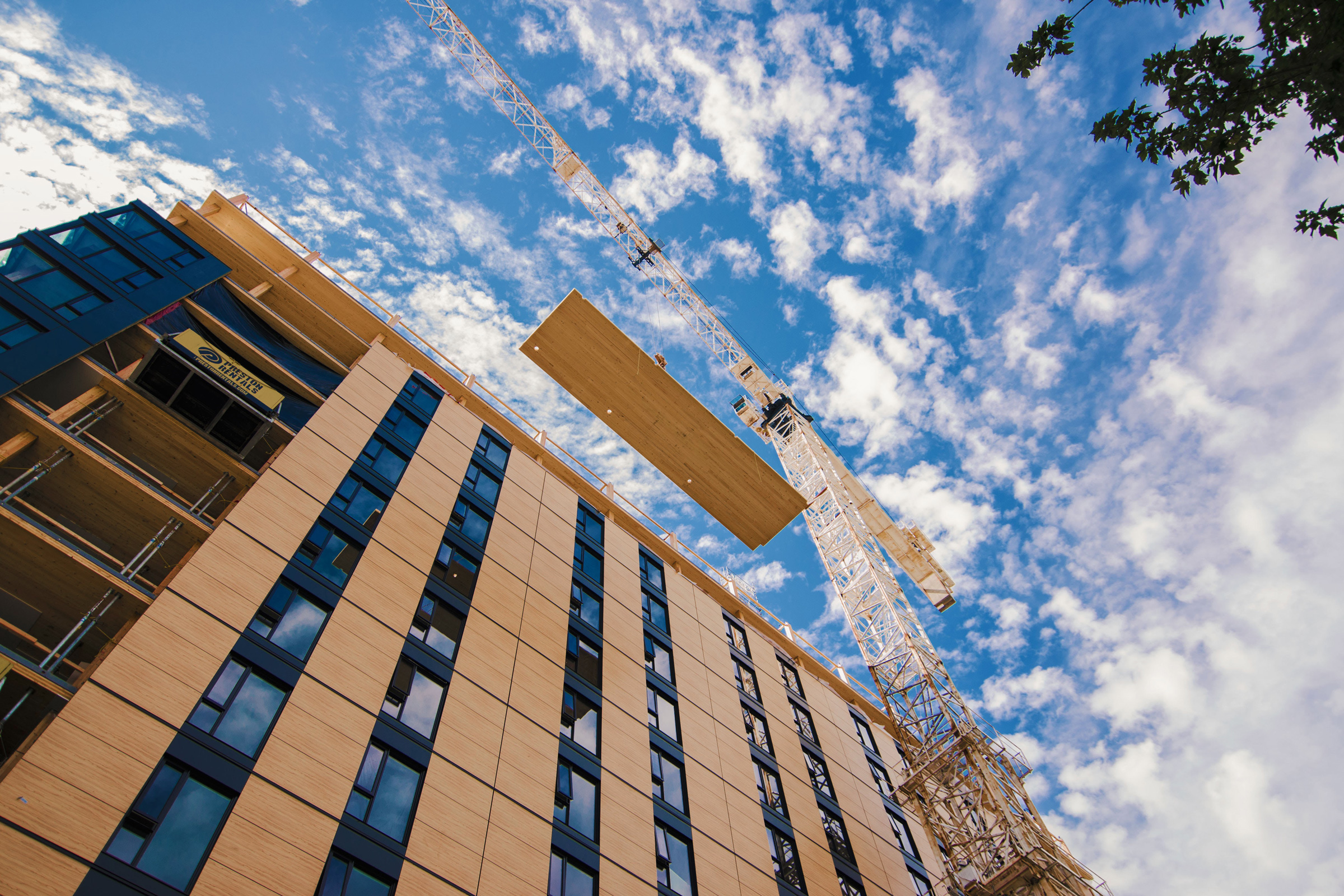
The Brock Commons Tallwood House is Canada’s tallest mass timber building. Photo by Pollux Chung
Part of the University of British Columbia’s Point Grey Campus, the aptly-named Brock Commons Tallwood House in Vancouver is the tallest mass timber building in the country, at 174 feet tall.
Designed by Acton Ostry Architects, this 18-story student housing building—capable of housing just over 400 students—was considered the tallest mass timber structure in the world when it first opened in 2017.
The Brock Commons Tallwood House’s frame is built from prefabricated engineered timber, whereas the foundation and center structural cores are made from concrete—steel was also used for some structural and roofing elements. All of the building’s above-grade floors feature five-ply CLT panels and glulam columns in their construction.
Due to the use of lightweight prefabricated timber elements, the Brock Commons Tallwood House was able to be erected much faster than a steel-and-concrete structure of similar height, while also producing less waste.
14. Wurriki Nyal Civic Precinct Council Hub, Victoria, Australia
Designed by COX Architecture for the City of Greater Geelong (CoGG), the Wurriki Nyal Civic Precinct Council Hub is nearly 171 feet tall, making it the second-tallest mass timber building in Australia.
The Wurriki Nyal—a Wadawurrung phrase that translates to “speak and talk together”—Council Hub brings together all of the CoGG’s various departments into a unified, collaborative workspace and employs design elements intended to honor the region’s Aboriginal cultural heritage.
A hybrid structural system consisting of concrete, steel, and mass timber was used for the project; CLT floor panels, as well as glulam beams and columns, can be found throughout the building and help create a healthy, inviting workplace that is both socially and environmentally sustainable.
Having officially opened in 2022, the Council Hub has since gone on to achieve a bevy of sustainability credentials, including a 6-Star Green Star Rating and several 6-Star NABERS ratings across various categories.
15. Treet, Bergen, Norway
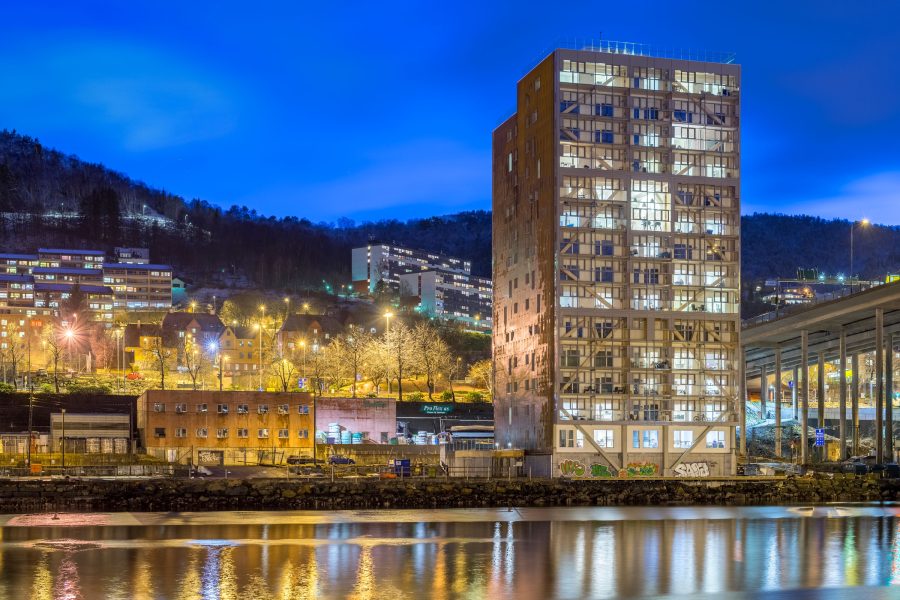
Treet, in Bergen, was designed by ARTEC. Photo by David Valldeby
Treet (which translates literally to “The Tree”) is Norway’s third-tallest mass timber building and nearly 161 feet.
The ARTEC–designed Treet in Bergen is an all-timber construction that honors Norway’s long history of wood-building. Treet rises a full 14-stories off the ground and houses 62 residential units and features a glulam timber framework, CLT balconies, elevator shafts, and staircases as well as prefabricated living modules.
To protect the building from the elements ARTEC elected to clad the east and west faces with Corten steel and the south and north faces in glass. Power floors and concrete slabs were used to provide stability and help Treet manage prevailing wind loads.
Each modular unit in the building is designed to be independent of the others; they all boast their own walls, floors, and ceilings—and were lifted into place by crane. Proximity to Bergen’s harbor allowed for supplies to be delivered by ship, while also ensuring excellent views for Treet’s occupants.
16. Lighthouse Joensuu, Joensuu, Finland

Finland’s Lighthouse Joensuu is the tallest mass timber building in the country and provides housing opportunities for local students. Photo courtesy of Arcadia
As the tallest mass timber building in Finland, the 157.5-foot tall Lighthouse Joensuu—which, incidentally, isn’t a lighthouse, but a residential building for students—is a stalwart example of subtle timber construction.
Though you may not know it from the outside, Lighthouse Joensuu’s framework is constructed almost entirely from wood; only the ground floor is built from concrete. This was intentional on the part of the building’s designer, Arkadia Oy Arkkitehtitoimisto, as wood is significantly more sustainable than concrete and steel in that it absorbs and stores carbon throughout its life cycle.
LVL timber was used for the building’s wall frames and cross-glued CLT makes up the structure’s intermediate floors. In accordance with fire codes and regulations, these wooden surfaces are covered with either plasterboard or stone cladding.
In 2019 Lighthouse Joensuu received the ‘Puupalkinto’ Wood Award for its pioneering work in timber high-rise design.
17. 25 King, Brisbane, Australia
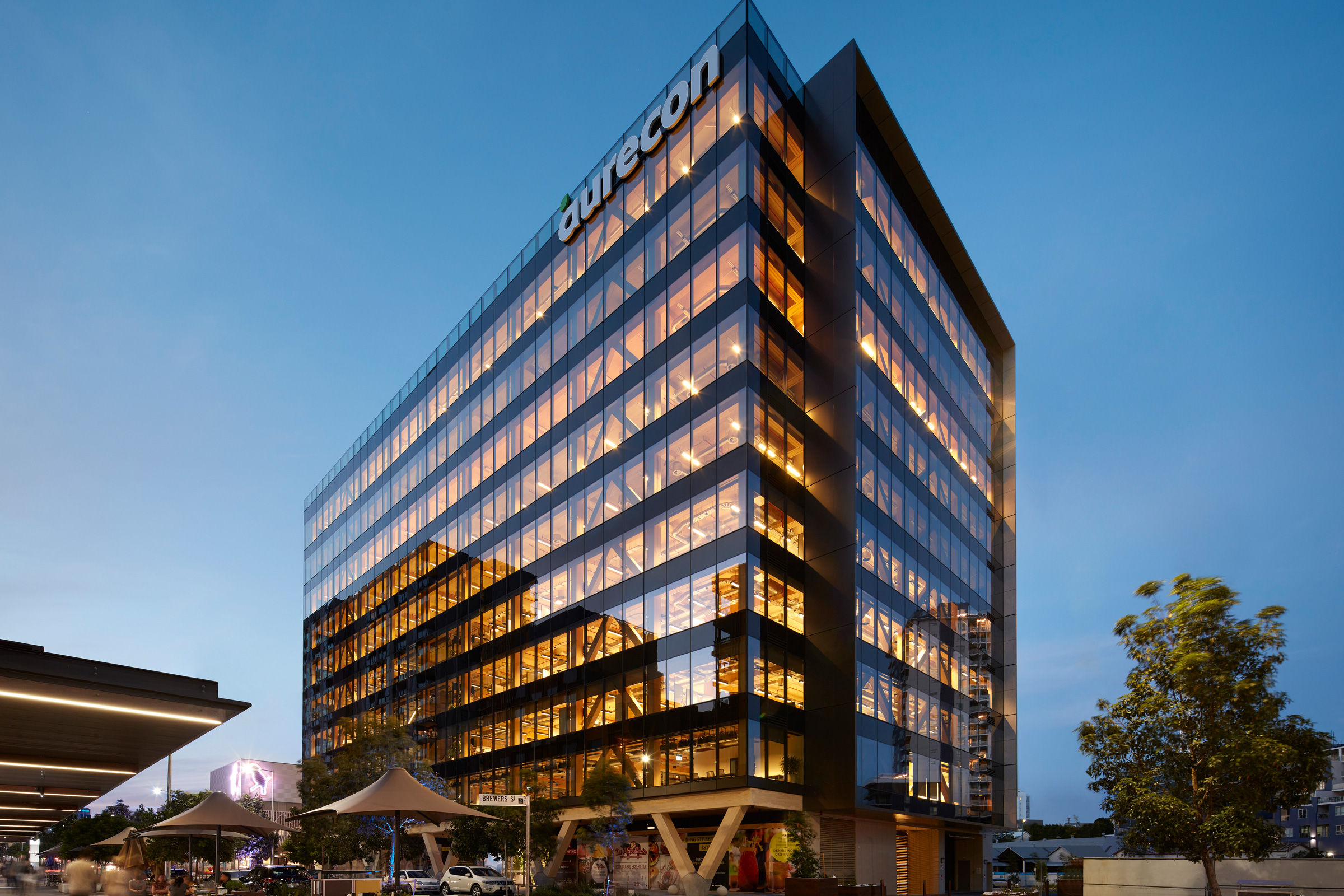
Located in Brisbane, Australia, 25 King is the second tallest mass timber building in the country. Photo by Tom Roe
The second building on our list designed by Bates Smart, the 25 King office building in Brisbane is 153.5 feet tall with 11 floors.
Considered an all-timber building, 25 King is built almost entirely from engineered wood. Starting from the second floor, the building utilizes a simple column and beam structure made from glulam, whereas the core walls, ceilings, and floor planks are all made from CLT. Diagonal glulam braces were also used to provide additional lateral support for the building’s facade.
The only major components of the structure that are not built from timber are the basement and ground floor—rather, both are made from concrete to preemptively avoid moisture and insect damage.
25 King’s street-level entryway features an angled colonnade or veranda whose beams and supporting v-columns are clad in Accoya timber.
18. HOAS Tuuliniitty, Tapiola, Finland
While not the tallest mass timber building in the world, the HOAS Tuuliniitty building is the tallest modular wooden building in the world, at approximately 144 feet tall.
Located in Tapiola, Finland and designed by architects Tuomas Saarinen and Jukka Turtiainen, the HOAS Tuuliniitty building was built using prefabricated solid-CLT volumetric modules. These wooden modules were constructed almost entirely offsite before being transported to Tapiola and lifted into place, significantly reducing the amount of construction site waste.
For structural reasons, a thick concrete slab was used to stabilize the structure’s base. HOAS Tuuliniitty’s framework also incorporates the use of wood-against-wood joints, which help to reduce strain from strong headwinds.
At 13 stories tall the HOAS Tuuliniitty building houses 165 student apartments as well as standard residential amenities. It is owned and operated by the Helsingin Seudun Opiskelija-Asuntosäätiö—a student-housing provider in Helsinki.
19. T3 Bayside, Toronto
Developed by Hines, T3 Bayside is said to be North America’s tallest mass timber office building, at 138 feet in height. The 10-story building on the shores of Lake Ontario is one of many projects in Toronto’s 2,000-acre waterfront revitalization initiative.
Designed by renowned Danish architecture firm 3XN in collaboration with WZMH Architects, T3 Bayside reflects Hines’ ongoing commitment towards sustainability thanks to its extensive use of mass timber—supplied by Nordic Structures, a leader in sustainable engineered wood solutions—and focus on environmental wellness.
T3 Bayside’s timber construction slashes its embodied carbon by an estimated 40 to 50% compared to traditional office buildings—an amount equivalent to removing approximately 2,700 cars from the road. The use of mass timber also helped to reduce construction times and will facilitate ease of disassembly, allowing the materials to be reused in the future.
Beyond sustainability T3 Bayside’s use of exposed mass timber also serves to define both interior and exterior aesthetics—helping to create a warm, welcoming environment—while simultaneously reinforcing tenants’ connection to the natural world.
Completed in 2023, T3 Bayside has already achieved WiredScore Platinum certification and is currently targeting both LEED Gold and WELL certification. The project also received a 2023 FSC Leadership Award in recognition of its use of responsibly-sourced FSC-certified glulam beams and CLT floor and roof slabs.
20. District 56 Tallwood I, Langford, British Columbia
Developed by Design Build Services and designed in collaboration with Jack James Architect, District 56 Tallwood I is 137 feet and 12 floors. District 56 Tallwood I is the first tall mass timber building on Vancouver Island and the second-tallest encapsulated mass timber building in British Columbia.
The building’s ground floor sits on a concrete podium and houses commercial space while the remaining 11 stories are dedicated to residential units, with the top level consisting of four penthouse suites, each featuring vaulted ceilings made from exposed CLT. As a 12-story timber building, however, all other mass timber used in the building’s construction—e.g. the point-supported CLT floor plate and glulam columns—is encapsulated to ensure all fire code requirements are met.
Because the project is in Langford—one of the more seismically active areas in British Columbia—it sports a lateral system made from ductile, eccentrically braced steel frames; combined with the use of structural mass timber, such a system makes District 56 Tallwood I well-suited to weathering earthquakes.
21. Origine Building, Quebec City
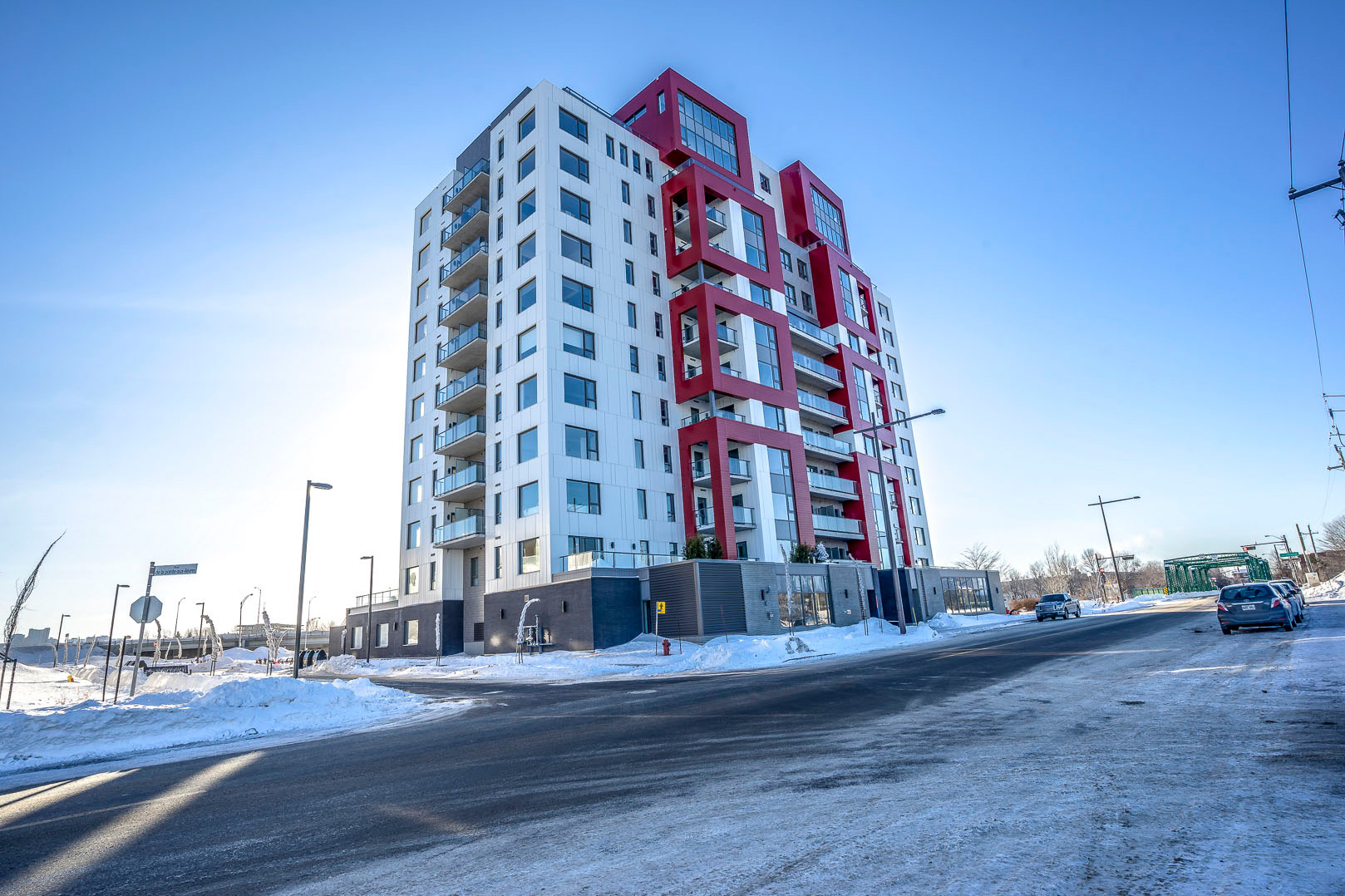
When it was completed in 2017, the Origine building held the record for tallest mass timber building in the world. Photo courtesy of Agence M
Designed by Yvan Blouin Architecte, the Origine residential building in Quebec is 134 feet tall, with 13 stories. At the time of its opening in 2017 Origine held the record for tallest mass timber residential building in the world.
When the tower was first proposed in 2014, constructing a 13-story mass timber building was practically unheard of. Quebec’s construction codes all but ruled out wood in projects exceeding four stories tall, as it was necessary for them to be fire resistant—something timber isn’t traditionally great at.
The team behind the project persisted and developed adequate equivalent measures to ensure that Origine could be built from timber without jeopardizing occupant safety in the process. Ultimately mass timber was able to be used on all 13 of Origine’s floors. Black spruce CLT was used for the load-bearing walls, shear walls, flooring, and roof, while glulam timber beams and posts make up the structural system.
Today Origine houses 92 apartment units and continues to set an example for tall-timber construction in Canada.
22. T3 Sterling Road 5A Building, Toronto
At 130 feet tall, T3 Sterling Road’s 5A Building is eight floors of modern office space. Developed by Hines and designed by the DLR Group in collaboration with WZMH Architects, T3 Sterling Road 5A emphasizes talent, timber, and technology, encompassing a range of collaborative workspaces and top-tier amenities.
The building makes use of dowel laminated timber for its floors, of which are in turn supported by glulam post and beam framing. At the time of its construction, the project’s eight floors rose above local code limits for mass timber, but StructureCraft—the company who sourced, supplied, and installed T3 Sterling’s structural timber—submitted an Alternate Solutions Report to the City of Toronto, allowing exposed timber to be used nearly everywhere throughout the building.
Beyond aesthetics, exposed timber is known to be beneficial from a biophilic wellness perspective, as surfaces made from natural materials can actually help to boost cognitive function and improve productivity.
Completed in 2024, T3 Sterling Road Building 5A is targeting both LEED and WELL certifications as testament to its sustainability- and wellness-focused design.
23. INTRO Cleveland, Cleveland, OH
One of the US’ top five tallest mass timber buildings, the nine-story INTRO Cleveland building is 130 feet tall. The multifamily residential project was designed by Hartshorne Plunkard Architecture for Harbour Bay Real Estate and houses 298 luxury apartments as well as 40,000 square feet of commercial retail space.
INTRO’s structural system consists of eight mass timber floors on top of a one-story concrete podium, with approximately half of all CLT floors/ceilings and glulam beams/columns left exposed as an intentional aesthetic choice. Like T3 Sterling Road, the INTRO building was able to leave so much of the timber structure exposed despite its height as a result of submitting an Alternatively Engineered Design report to the City of Cleveland.
Austrian mass timber provider Binderholz supplied more than 7,000 cubic meters of CLT BBS and glulam—made from blond hem-fir and spruce trees sustainably harvested in the Austrian Alps—for the project.
Extensive use of mass timber helped reduce INTRO’s carbon footprint by 21% compared to an equivalent concrete or steel building—one of many factors that helped the project earn LEED Gold certification at the time of its completion in 2022.
24. Sensations, Strasbourg, France
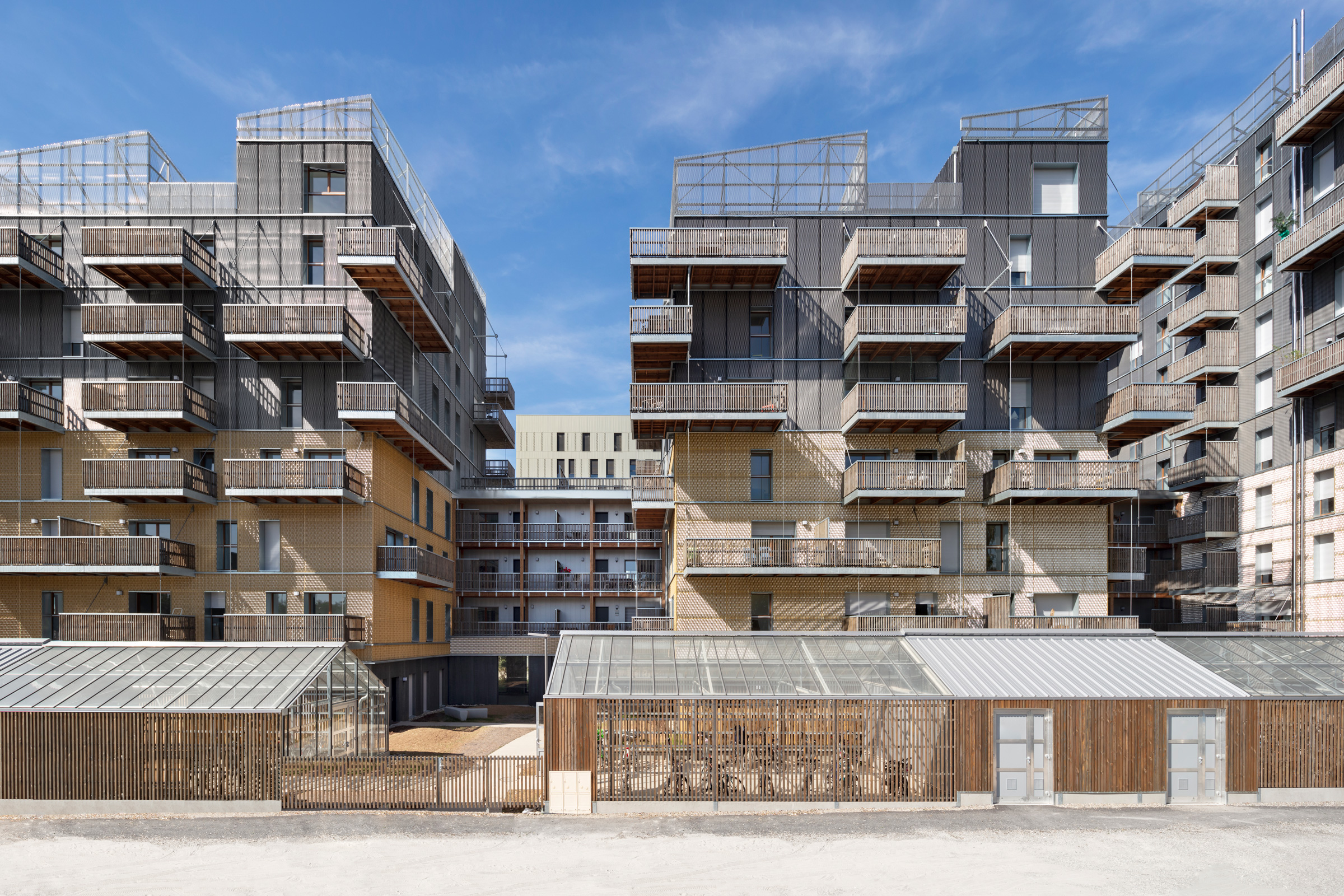
The 125-foot Sensations building is the tallest mass timber building in France. Photo by Septet
KOZ Architectes designed the 11-story Sensations residential complex in the heart of Strasbourg to be nearly 125 feet tall, making it the tallest all-timber building in France.
With a frame and envelope composed entirely of wood, Sensations is an inspiring example of how engineered timber may be used in place of high-emission materials like concrete and steel. The only concrete in the building, used for stairs and the ground floor recovery charges, is there to meet regulation requirements.
From there the majority of the building—including all load-bearing walls—is constructed from CLT and features a glued-laminated beam-to-beam structure. Wood is used for the exterior cladding up to the fourth floor, after which point it transitions into aluminum paneling.
In 2020 Sensations received the National Wood Construction Award in the “Living Together” category. The building is part of Strasbourg’s so-called “wood block,” which serves to demonstrate how timber may be used to build at height, even in urban spaces.
25. Rundeskogen Hus C, Sandnes, Norway

All three towers in the Rundeskogen complex implement mass timber cladding on the fins radiating outward from their central bases. Photo by Sindre Ellingsen
Returning to Norway, the Helen & Hard architecture studio–designed Rundeskogen Hus C—the shorter counterpart to the aforementioned Hus B—is just over 121 feet tall, making it the second-tallest building in the Rundeskogen complex.
Sharing an identical base structure with Rundeskogen Hus B, Hus C is meant to invoke the shape of a tree and utilizes mass timber on the fins which radiate outward from its trunk-like base.
Rundeskogen Hus C’s shape and orientation was devised so as to maximize views of the surrounding area and make efficient use of natural sunlight throughout the year. Public green spaces surround the premises and help connect existing buildings at the site’s southern end to forested areas at the northern end.




